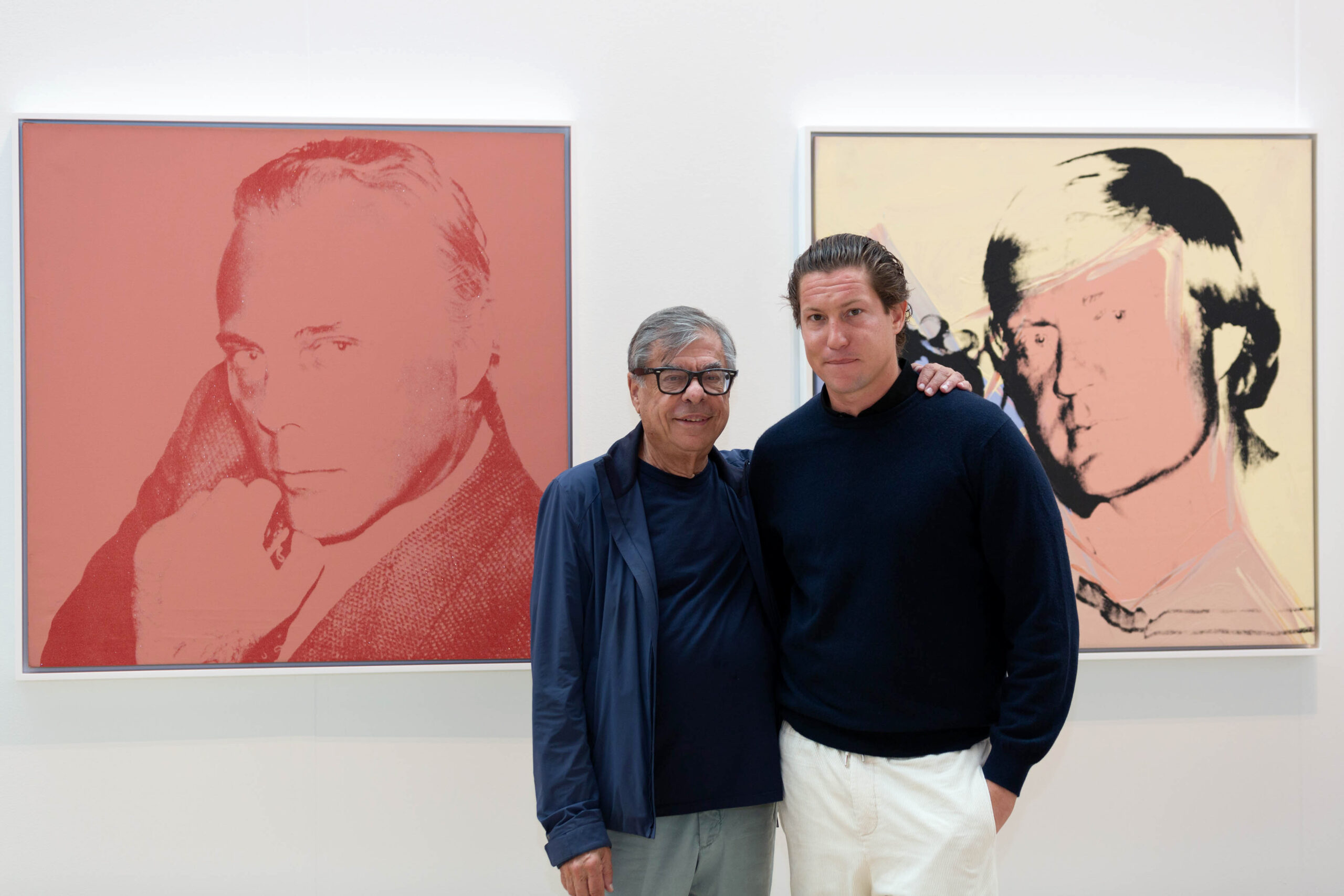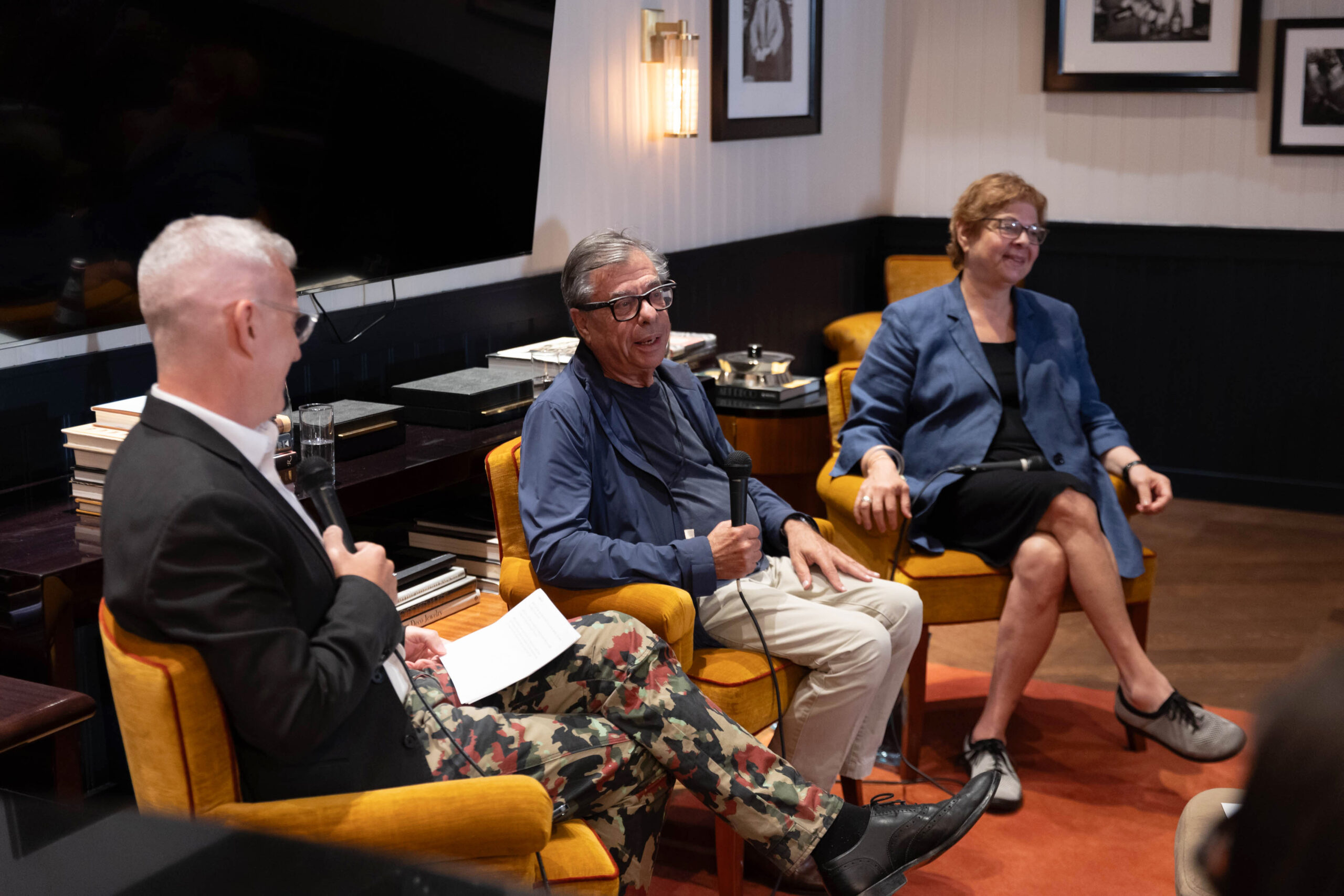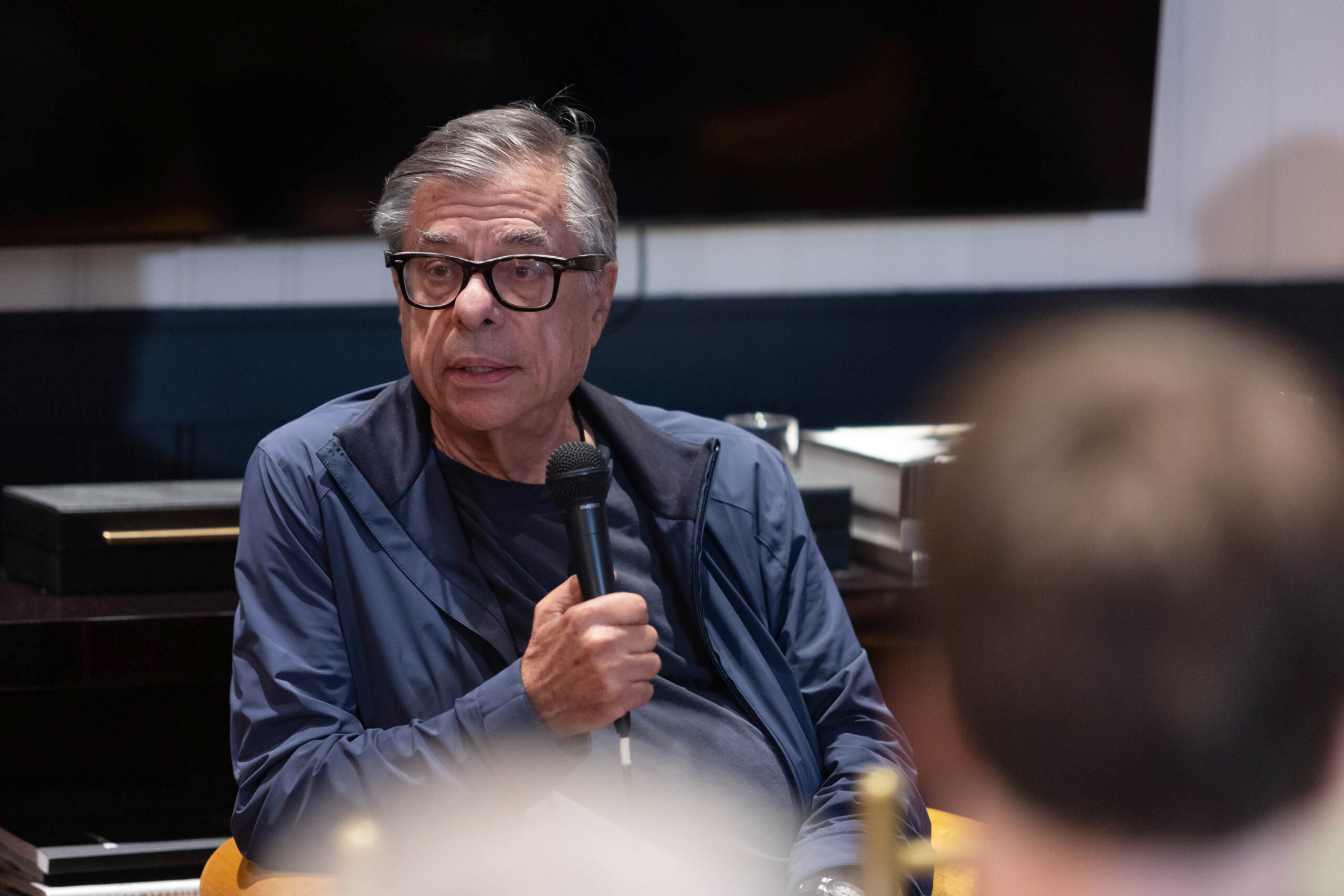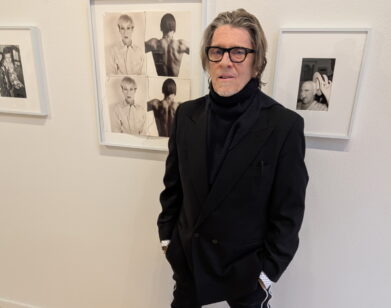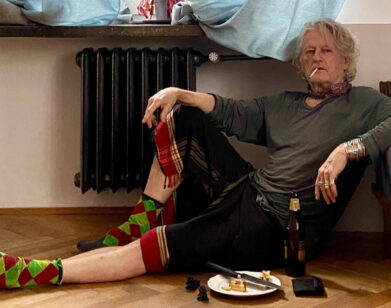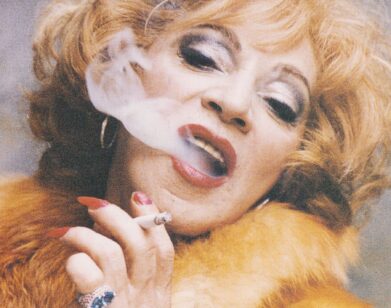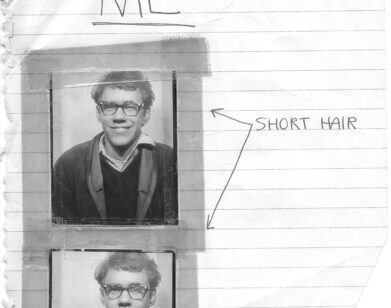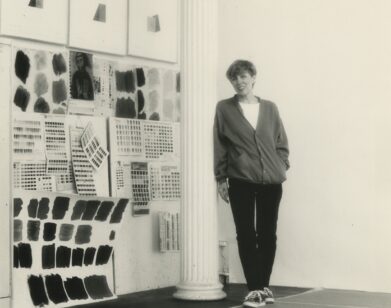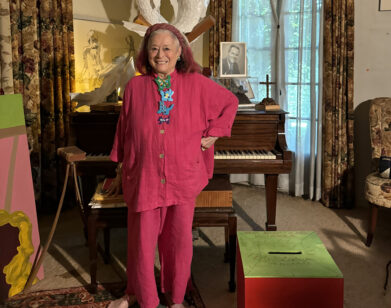ICON
Bob Colacello on the “Secular Saints” of Andy Warhol’s Portraits
During Bob Colacello‘s formidable reign as editor of Interview Magazine from 1970 to 1983, he was often tasked with “popping the question.” In Warhol parlance, this meant asking pop stars, artists, socialites, heads of state, and princesses if they wanted to be immortalized in portrait form by Andy Warhol himself. “I always said I never had to social climb,” remarks Colacello, who appeared on a panel last week at Cipriani South Street with Michael Dayton Hermann of The Andy Warhol Foundation and Donna De Salvo, formerly the Chief Curator at The Whitney Museum of Art. “I landed on Mount Olympus in Andy’s helicopter.” Their conversation, which appears below, edited for brevity and clarity, was facilitated by Independent 20th Century and Vito Schnabel Gallery, where 10 such portraits, featuring Giorgio Armani, Judy Garland and Liza Minelli, were on view. Below, Colacello, Hermann, and De Salvo discuss Warhol’s enduring influence, a day in the life at “the factory,” who Andy would want to paint today, and what it’s like to have Diana Ross cut you a check for a couple-hundred thousands dollars.
———
MICHAEL DAYTON HERMANN: It’s a pleasure to be here with Bob and Donna. I expect this will be a very lively, engaging and fun conversation about Warhol’s commission portraits. I will open with a quote by Warhol. He said, “Being good in business is the most fascinating kind of art.” He’s certainly known for blurring the boundaries between art and commerce, and he really challenged us to see the world differently. He shared that idea with you, Bob, and I’d love for you to talk a little bit about what this larger idea was, which utilized the commission portraits.
BOB COLACELLO: Well, the thing about Andy and the commissioned portraits is he was quite flexible in wanting to please the clients and would ask them what colors they liked. And of course, during the Polaroid process, they would say, “Andy, I like this one. Please don’t use that one.” So there was an exchange, but he was very rigid about the size. Occasionally, clients would say, “I’d like 36 by 36 inches instead of 40 by 40.” Others wanted a little larger. And Andy was like, “No, it has to be 40 by 40.” So one day I asked him why. He said, “Because someday, Bob, I want one panel of every person I painted all put together in one big painting that all lock into each other and I want to call it Portrait of Society. And I would like it to be at the Met.” Andy’s idea of society was not just families who came over on the Mayflower or British aristocrats. It was a global kind of society. Yes, there were some titled aristocrats, heads of state ranging from Golda Meir to the Shah of Iran to Jimmy Carter. But there are also athletes, lots of society, ladies, artists. So the commission portraits are not sort of side works or minor works because Andy didn’t choose to paint those particular people. They came to him. He took that work as seriously as he did any other work. But of course, while acting like he wasn’t being serious at all. That was Andy’s thing, to be very flippant about his own work and his own importance.
HERMANN: How do you see these portraits in relation to all of Warhol’s work?
DONNA DE SALVO: Well, it’s interesting because when we began the project, I felt it was very important to have the portraits in the exhibition. When they had been shown at the Whitney in ’79, long before I was there, they were trashed. I mean, just terrible reviews in The New York Times. But the reality is that the trajectory of portraiture begins way back in the fifties and really continues all the way through. The idea of commissioned portraits is nothing new in the history of art. But in the sixties and into the seventies and eighties, no one was doing portraiture in the “serious” art world. Warhol was doing his thing. The earliest portrait was from 1969, and it was of Jermayne MacAgy, who was a curator and a muse to Dominique de Menil in Houston. I think Dolly Parton was at the very end. She was the one who drove us crazy because, when it arrived, it was like 42 by 42.
COLACELLO: When did that happen? I wasn’t there.
DE SALVO: We were like, “Oh my god, the grid! What are we going to do?” And it was like, “Well, we’re just going to go for it ’cause she’s all hair anyway.”
COLACELLO: I gave several tours of the exhibition, Donna asked me to. And I couldn’t get people to leave the portraits room, which was on the ground floor. Someone from the museum would say, “Bob, you’ve used up 45 minutes of your hour.” But people wanted more and more stories behind how each of these portraits came to be. And again, the variety is amazing, and the stories are interesting. We’d call this little presentation at Vito’s Gallery, “Popping the Question.” I would say to Andy, “I had dinner with Lily Auchincloss last night.” He’d say, “Did you pop the question?” It was like, “No, Andy, I didn’t pop the question. She already said she doesn’t want to look at herself at 40 by 40 in bright colors.” She was an old wasp. Andy would say, “Bob’s great, ’cause he can talk to anyone and he could sell a lot of portraits.” So even though I was editor of Interview, I was in effect paying my own salary because the portraits really did keep Interview and the video projects going, which were not profitable until the early 80s. So we were under pressure to sell, but we did get a commission, which came in handy because Andy kept salaries pretty low to give you more incentives to sell art. He was a good businessman. He believed in business art, and he was good at it.
HERMANN: I’d love to hear you talk a little bit about what Andy was like as a boss. I hear you talking about him asking you to “pop the question” and push sales. Did he apply any pressure?
COLACELLO: Andy would talk to Pat Hackett first in the morning and dictate his diaries. Then he would usually call me to see what I did the night before. I stayed out later in those days, but it would be like, “Oh, I saw you talking to Calvin Klein at Studio 54 last night. Did you sell any ads?” “Andy, it was three in the morning when I was talking to Calvin.” He was like, “Bob, that’s the best time to sell ads.” In other words, people are drunk and they’ll agree to anything. You were under pressure from Andy. But every so often I’d say, “Andy, you’re making so much money, you’re really raking it in.” He’d say, “I’ve got to bring home the bacon. I have so many mouths to feed.” I’d say, “Why don’t you give yourself a break, and give me a break too? I mean, do we have to go to six parties every night to sell?” But Andy was also going to six parties every night to record. John Richardson called him ‘The Exterminating Recorder.” But when I would say to Andy, “You’re making so much money.” He’d say, “Bob, have you ever heard of Tchelitchew?” And I’d say, “Yes, I heard of Tchelitchew.” Tchelitchew was a surrealist, a sort of late surrealist, who in the 1940s and early 50s did a lot of society portraits. And Andy said, “Well, everyone had their portrait by Tchelitchew, and then one day nobody wanted a Tchelitchew portrait. That could happen to me. So you’ve got to sell them fast, Bob.”
HERMANN: And how much did they cost?
COLACELLO: They cost $25,000 for one panel and then $15,000 for each additional one. My favorite client was Diana Ross, because she had portraits of herself and her three daughters done and her bill was a couple of hundred thousand dollars. And I said, “Where do I send the invoice?” She said, “No, I don’t want an invoice. I’m going to write a check right now.” I always said I never had to social climb [because] I landed on Mount Olympus in Andy’s helicopter. One day it was Mick Jagger. The next day it was the Chinese ambassador with the Iranian ambassador. The next day it was Bob Wilson or Cy Twombly.
HERMANN: So Andy didn’t always “pop the question.” Some of these portraits that he created during this time were not commissioned, and some of those were included in your exhibition, Donna. Do you distinguish between the two, aesthetically, conceptually, and perhaps in how Andy approached them?
DE SALVO: I was thinking about the drag queens a lot because we had a lot of discussion about the Ladies and Gentlemen series. They were commissioned by an Italian collector who originally wanted Andy to do Candy Darling and people from The Factory and he did not want to do that.
COLACELLO: It was [Luciano] Anselmino of Torino, who was a dealer. We were in Turin with him, and then we were going to Monte Carlo. And on the car ride on the way back, Anselmino said, “I have this great idea. I want you to paint transvestites, but not successful ones that really pass like beautiful women. But ones that have heavy beards coming, five o’clock shadows coming through their makeup.” And Andy was like, “Bob has a five o’clock shadow.” I was like, “Andy, I’m not posting that.” It went on for the whole next month, because Andy was terrified of getting involved with transvestites again. Holly Woodlawn would show up and have a fit because she was only paid $25-a-day to appear in the movies. So he put all this pressure on me to be the model. And finally, one day, I guess I had one vodka too many at lunch and I said okay. And Andy kept saying, “No, do this with your hands. Bob, you’re really a terrible drag queen.” I said, “Because I’m not a drag queen and I don’t want to be.” So we gave up that idea.
HERMANN: I thought you looked good.
DE SALVO: One thing I just wanted to add, when you were talking about bringing home the bacon. I think the other thing that’s important to remember is that much of the work that he was making in the seventies and the eighties wasn’t highly successful commercially. So this also allowed him to continue to have some of these explorations into the hammer and sickle, skulls, the shadows. I did two interviews with him in ’86, and this was a revelation for me, but I asked him about artist studios he went to. And he told me he went to Ad Reinhardt’s studio, and that kind of surprised me in some way. He said, “Yeah, I looked at those paintings. They all looked like the same thing, but they were all complicated underneath.” And it linked with what he talked about with the Campbell soup cans because he said, “People just want a soup can.” But if you think about the great series that MoMA has, they’re all soup cans, but they’re all different. And I just thought of the whole idea of seriality, the conceptual side. The sophistication with which he saw things was just extraordinary.
COLACELLO: Well, that’s a point that I wanted to make in this presentation that I did for the Fair here. In the early seventies, the ’72 portrait of Hélène Rochas, the ’74 portrait of Rikky von Opel, you see all this gestural. Andy would say, “Oh, people in Paris are more intellectual.” He called it “doing the de Kooning.” Should I do a little de Kooning? But again, that was Andy making fun of his own work. It was one of the great charms of Andy was that he was not pretentious; he never hung his own work in his own house. He was always like, “Oh, I don’t know what I’m doing.” It kind of fit into his pop art. Andy understood fame and he liked being famous. And what he’d actually say in interviews was, “I’m just a traveling society portrait painter and I follow my hairdresser, Fred Hughes. He tells me what to do.” But again, you could see in the work, it’s very serious. He tailored the look of each portrait, the style of each portrait, to the client. So Giorgio Armani has diamond dust in the silk screen. In Keith Haring, you see this almost electric effect in the way Andy played with the colors.
DE SALVO: And many of the artists are done in black and white.
COLACELLO: That’s interesting.
DE SALVO: There’s so much discussion about Warhol and business and all of that, and I do think that what’s so important with artists like Warhol is the class issues. He was from a working class, immigrant family–
COLACELLO: Poverty-stricken.
DE SALVO: His father worked in the mines and died when Andy was relatively young. So I think that was a motivator. I think he probably thought he could run out of money at any time. It’s like the Tchelitchew thing. And I think that’s a huge aspect of his understanding of things, too, of the world, his fascination with moneyed people. And I think that goes with the portraiture itself, in Andy’s being tuned in to certain aspects of an individual. The Versace portrait that we had was absolutely ghostly given that he was murdered.
COLACELLO: Several people said today about the one in the show here, which is black and white. “Oh, he looks so somber. He looks so gloomy. Andy must have been foreseeing his murder.” I mean, he does look gloomy and severe, but I think Versace kind of wanted it to look that way.
HERMANN: Bob, take us inside The Factory. What was that atmosphere like? Was there music playing? Was Andy socializing? Were other people around? How did this unfold for the various subjects?
COLACELLO: I mean, The Factory was an office. One part of it was the Interview office. So we had about 10 people working there, getting the next issue ready, people typing up transcripts in the front reception area. Brigid Berlin was sort of pretending to type Andy’s tapes from the night before, which were unintelligible. We had a little art deco furniture, Bugatti furniture. And we would have these lunches that were very freeform, but Fred and I mainly invited people spur of the moment. Although if we knew somebody from Europe was coming, we wanted to get their New York friends together. It was a little bit random and people liked that because they’d see people they didn’t know or they wouldn’t see any place else. And we’d serve white wine, red wine, nothing fancy, tuna and egg salad sandwiches and people loved it. But the portrait clients might come to lunch and then, after they’ve had a few glasses of wine, they pose after lunch. It became a little more formulaic as it went on. We’d go to Miami, we’d be at the Fontainebleau or wherever we were staying, and these ladies would be brought in one after another, every two hours on the second hour. And it was like, Andy didn’t even get to have any sense of who they were. When you see the portraits of a Lynn Wyatt or a Carolina Herrera, they’re really strong because Andy knew those women. He sat next to them at dinners. He made jokes with them. I think they lost something when this kind of factory-like approach took hold.
HERMANN: I think that’s an interesting segue to a question for Donna. You curated an exhibition at The Parrish Art Museum called Face Value, and included in that exhibition were a couple of commissioned portraits. As Bob is explaining, there were a lot of people coming in and commissioning portraits. And at the time, Warhol passed away. There weren’t always records and documentations to identify who they were, and yet paintings were left with the estate and then the Foundation. I’d love to hear you talk a little bit about how these paintings operate.
DE SALVO: So, that was an exhibition that happened in ’95, a long time ago. And it was really inspired to a certain extent by the resurgence of interest at that time amongst a younger generation of artists actually working in portraiture. Cindy Sherman, Chuck Close, Lyle Ashton Harris. And then The Parrish has the estate of William Merritt Chase. So there was a group of historical portraits, and the exhibition went from the late 19th century right up to the present. I wanted to include Warhol, but I wanted to do something a little bit different. And I reached out and I said, “Do you have any portraits of people that you don’t know who they are?” And they did. It was fascinating to see them amongst like, Robert Henri and William Merritt Chase. Because the thing about Warhol, he is part of that incredible trajectory. Warhol’s formative years in New York are really the heyday of abstract expressionism where, if you were a figurative artist, you were on this side. If you’re an abstract artist, you were on this side. I mean, it was a very clear delineation. But he made this statement, which I just think was liberating for a whole new generation of artists. He says, “I don’t understand why you can’t be an abstract painter one day and a portraitist the next day.” That, to me, is the condition from the sixties forward. So I always loved that statement.
HERMANN: That’s really one of Warhol’s powers, the freedom and liberty he’s given generations since to define what it means to be an artist for themselves and not to be confined by conventions. That’s a good transition to the closing questions that I have for you. First, if Andy were alive today and asked you again to pop the question, who would you reach out to and why?
COLACELLO: Oh, god. Well, Andy would want me to get Kim Kardashian and put her on the cover of Interview Magazine. I’d be saying, “Over my dead body.”
HERMANN: You’d still get that commission. Just keep that in mind.
COLACELLO: Well, I think Serena and Samantha Boardman, the sisters. Vanity Fair did a feature at one point of descendants of people who’d been painted by John Singer Sargent.
HERMANN: And you, Donna?
DE SALVO: Of course, I thought of Kim Kardashian. I would’ve liked to see him do Lady Gaga.
COLACELLO: That’s a good choice.
DE SALVO: She’s a great talent. She’s flamboyant. Maybe she would’ve been wearing the meat dress on or something. I think he would’ve been fascinated by her as a personality.
COLACELLO: Yeah, I think much more than Madonna, Lady Gaga is really creative. I think she’s sort of a surrealist at heart.
HERMANN: My vote is Beyonce. I’ll be on the record with that one.
DE SALVO: I did a tour for Jay-Z of the exhibition. Beyonce couldn’t come until later in the day, but I had to go to a friend’s Christmas party. But it was amazing to walk him through that show. He loved the portrait room. He really spent a lot of time with it. HERMANN: The cover of his book has a Warhol Rorschach. Bob, of the 10 works that are in the Vito Schnabel exhibition here that you curated, if you could take one of them home, which one would it be and why? Same question for you, Donna.
COLACELLO: It would be Vincente Minnelli, who’s Liza Minnelli‘s father, but was a great MGM director, particularly of musicals like Meet Me in St. Louis and Three Coins in a Fountain. I love that portrait because, for me and for others, Andy was the greatest colorist of his generation. John Russell of The Times of London wrote in 1970 that Andy was the Matisse of acrylics. And I love that portrait of Vincente Minnelli, the way it has four quarters, sort of cantaloupe bouncing off like a tomato red and these two blues. HERMANN: And you, Donna?
DE SALVO: I would take home the one of Kimiko Powers. She is just an elegant woman. They were amazing collectors, her and her husband, John Powers. It’s just very beautiful.
HERMANN: It’s stunning. It really is. In conclusion, I would really like to just frame a question, which is a bit larger. Warhol is often seen as a mirror of his times and in many ways foreshadowed the world in which we’re living today. So, imagining this Portraits of Society exhibition at The Metropolitan Museum, what do you think that reflects about the time Warhol lived and what do you think it says today?
DE SALVO: Sure. I think that it absolutely talks about this cult of personality and celebrity. When we were conceptualizing the room, we thought a lot about Facebook, how it was kind of a Facebook of its time. Sports stars as celebrities, the star power of the sports figure. And there are things that are not there. There are limitations in some ways, there are very few people of color. It’s relatively white, but not totally. There are aspects of it that we would see as deficiencies, but that’s a given, that’s just world changes in good ways that are important. There’s still tremendous relevance.
HERMANN: The same question for you, Bob.
COLACELLO: Well, I think all of Andy’s work is very much about fame and this understanding, as he said in 1963, that in the future everyone will be famous for 15 minutes. That’s kind of come true. But having your portrait done by Andy Warhol made you, in a certain sense, famous. Andy’s work also was about making icons. I see Andy in some ways as making religious art for a secular time. Starting with Elvis, Marilyn, Jackie, and Liz Taylor, these are our secular saints. These were also martyrs. They were martyrs to fame. They were devoured by their fame. When you look at all these portraits, Andy is making people into icons. So I think they are still relevant today because once you turn something into an icon, it has a kind of permanence. Even Campbell Soup, you could argue, is an object of worship.
HERMANN: It sounds like Saint Andy is the patron saint of contemporary art.
COLACELLO: Well, his influence is everywhere still. Andy single-handedly legitimized photography with the silk screens. I remember that he wanted to trade portraits for Dalí. And Dalí’s very tough wife, Gala, would say, “No trade. Oil painting for photograph.” I’ll leave it at that.

